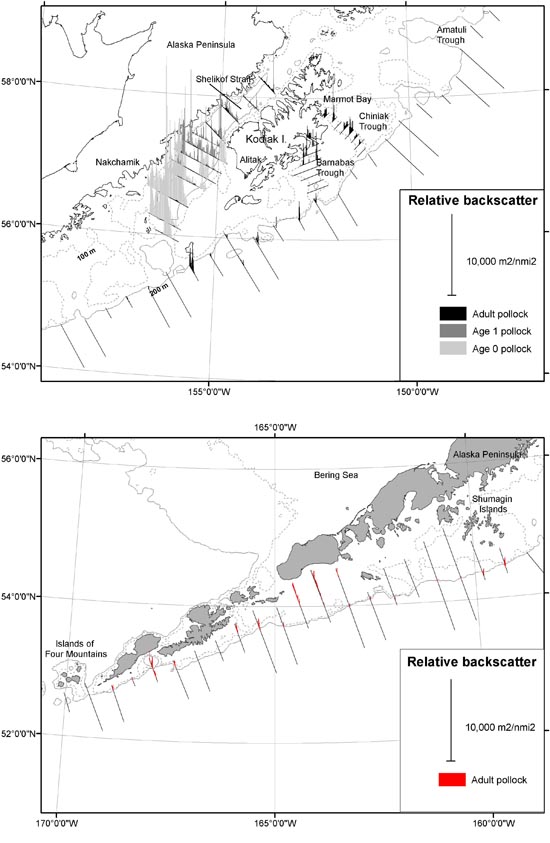Midwater Assessment & Conservation Engineering (MACE) Program
Oscar Dyson Gulf of Alaska Survey
An echo integration-trawl survey of the GOA was conducted 1-30 July 2005 using the NOAA research vessel Oscar Dyson.
The principal objective of the survey was to collect echo integration and trawl data to estimate walleye pollock abundance
and distribution. The survey originally began on 1 June but the vessel returned to Kodiak on 3 June because of mechanical
problems. Repairs were completed and the cruise resumed on 1 July. Pre-existing equipment problems mandated a 5-nautical
mile (nmi) minimum distance from shore for safety concerns. This limitation prevented the vessel from surveying along the
proposed trackline where significant pollock quantities were found during the 2003 GOA survey, including the Shumagin Islands
area, Nakchamik Island, Alitak Bay, and Marmot Bay.
Acoustic data were collected with a Simrad EK60 quantitative echosounding system operating at four frequencies (18, 38, 120,
and 200 kHz). Results presented here are based on 38 kHz data. Midwater and near-bottom echosign was sampled using an Aleutian
Wing (AWT) 30/26 midwater trawl. On- or near-bottom echosign was sampled with a Poly Nor’eastern (PNE) trawl with roller gear.
A midwater Methot trawl was used to target age-0 pollock and macrozooplankton.
The survey design consisted of parallel transects at 20-nmi spacing along the GOA shelf and shelfbreak from the Islands of Four
Mountains eastward to near the Shumagin Islands and then along the shelfbreak and seaward from the Shumagin Islands to Amatuli
Trough (Fig. 2 below). Alternate transect pairs extended about 30 nmi beyond the shelf break. Barnabas and Chiniak Troughs were
also surveyed using 6-nmi spacing and Shelikof Strait was surveyed using 10- or 20-nmi spacing. Echo integration and trawl data
were collected along the transects only during daylight hours. Nighttime operations included additional trawling effort, physical
oceanographic sampling, and rerunning portions of the tracklines for day-night comparisons.

Figure 2. Relative backscattering attributed to pollock along tracklines during the 2005 echo integration-trawl
survey in the Gulf of Alaska, OD2005-01. |
Pollock was the most abundant species caught in the 28 AWT hauls, comprising 59% of the total catch by weight, followed by
Pacific ocean perch (35%). In the 10 PNE trawl hauls, Pacific ocean perch (32%) was the most abundant species caught, followed
by pollock (20%) and Atka mackerel (20%). Euphausids (41%) were the dominant species in Methot trawls. Most of the adult pollock
echosign was detected in Chiniak and Barnabas Troughs and along the shelfbreak south of Kodiak Island (Fig. 2). Dense age-0 and age-1
echosign was detected in the southern part of the Shelikof Strait sea valley. No pollock were detected along the offshore transects.
By Mike Guttormsen
>>>continued
 |

|
JAS2005 quarterly sidebar
AFSC Quarterly
Research Reports July-Sept 2005
Contents
Feature
ABL Reports
FMA Reports
NMML Reports
RACE Reports
REFM Reports
Items
Quarterly Index
Quarterly Home
|

